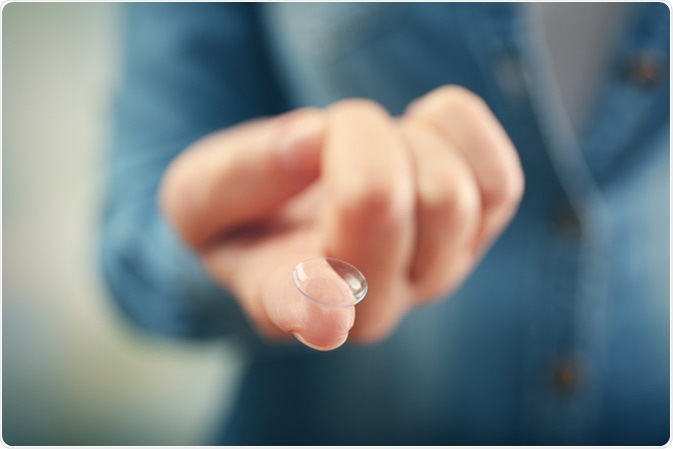Contact lenses are explicitly designed optical devices that can be worn directly on the cornea of the eye. People with poor eyesight wear contact lenses, which helps to refocus oncoming light rays on the retina to achieve a clear vision. Contact lenses increase or decrease the focusing potential of the cornea, and thereby directly project light onto the retina and aid in treating refractive errors.

Image Credit: Africa Studio / Shutterstock
Contact Lenses for Refractive Errors
Contact lenses are used to correct problems that are associated with the refraction of light by the eyes. Myopia, hyperopia, astigmatism, and presbyopia are the kinds of refractive errors. These refractive errors are treated by using different types of lenses.
Diverging Contact Lens for Myopia: In short-sightedness (myopia), the light ray from an object is focused in front of the retina and not on the retina. This makes the affected people see nearby objects clearly, but distant objects in a blurry manner. The contact lens used for this condition is a concave or diverging lens that raises the focal length of the light entering the eye. The concave lens has a thinner center and thicker edges that deviates the light gained from distant objects. The deviated light is then combined by the cornea and the lens of the eyes to produce a clear image on the retinal layer.
Converging Contact Lens for Hyperopia: In far-sightedness (hyperopia), the natural lens of the eyes has a decreased potential to refract light emitted by an object, thereby making the focus at a location beyond the retinal layer. The contact lens that is convex or converging in nature is used to correct this condition. The converging lens lowers the focal length of the light, and this proportionally reduces the distance of the image. It combines the light rays from an object before they enter the eyes. The converged light is then deviated by the lens of the eyes. Thus the combination of two lenses makes it possible to focus the image of nearby objects onto the retina.
Toric Contact Lens for Astigmatism: Astigmatism is a condition in which the light from an object that enters the eyes gets diverged to form multiple focal points on the retina, due to the abnormal shape of the cornea. People with astigmatism may not be able to see objects clearly; this condition can also occur in combination with other refractive errors like myopia and hyperopia, making it more complex. A specialized lens, known as a toric contact lens, is used to correct the bend in the cornea of the eyes, which causes astigmatism. It is designed such that the lens is able to establish various focusing potentials in the vertical and horizontal directions. The toric lens has different focal lengths and optical power formed at an angle of 90° with respect to each other. When the light rays of an object pass at right angles of the toric lens, the multiple focal points attained on the retina are corrected.
Monovision and Bifocal Contact Lenses for Presbyopia: Presbyopia is a universal eye disorder that is associated with aging.
The bifocal contact lenses have a concentric bifocal pattern; in other words, it is concave at the center but convex all around for a clear view of the near and far regions, respectively.
Wearing monovision contact lens is another option for correcting presbyopia, wherein the lens in one eye focuses on nearby objects, while that in the other eye focuses on distant objects.
HOW IT WORKS - Contact Lenses
New Technology Contact Lenses
Gas Permeable Contact Lenses: Gas permeable (GP) contact lenses maintain the shape of the cornea as they are rigid in nature and permit the oxygen supply to the cornea. The GP lens conceals the liquid lens present in the middle of the cornea and the lens and completely nullifies the abnormality in the front region of the eye. It also constricts the cornea to a milder level so that it can take up the proper shape of the back lens to provide sharper vision.
People with astigmatism can make optimum use of GP contact lenses. They can also be used in other conditions like presbyopia, myopia, and keratoconous.
Ortho-k (orthokeratology) contact lens are specially designed GP contact lenses that are worn during nighttime and removed during the daytime, for better vision in patients with short-sightedness. The contour of the cornea is reshaped temporarily by this lens.
Due to the slight pressure caused by the motion of the eyelids, a thin film rips from the lens and molds the cornea to attain a flat shape. This overnight process facilitates clear vision without contact lenses for more than 24 hours.
Contact Lens Without Vision Correction
Colored contact lens: This lens has no magnification effect but changes the appearance of the eye by providing colors.
Prosthetic contact lens: This lens is used to cover up the deformation of the eyes by overlapping on it in conditions like leukocoria. The increased complexion of prosthetic lens provide translucent coloring to the natural lens, thereby making a milder change in the iris, which eliminates photophobia.